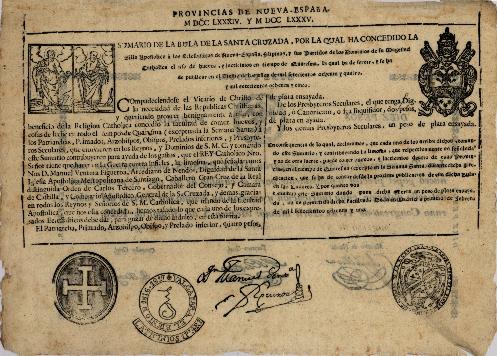| << Chapter < Page | Chapter >> Page > |
This ten pesos banknote is one of the national banknotes issued in 1823 under the new Mexican Republic. It was printed with the national seal of Mexico, the eagle on a cactus, and says the following:
"The National Treasury will pay TEN PESOS, precisely and exclusively substituting thisnew paper in exchange for those that bear the previous seal, whose fabrication and exchange has ceased in accordance with a decree issued by the sovereign Congress onApril 11 of last year. Mexico May 5, 1823." ( Ten pesos ).
To avoid the public’s rejection, as had previously occurred during the Empire, the government decided to print this new paper currency on the backs of Catholic bulls. The government made this decision based on the idea that the Mexican people’s religiosity would encourage them to use the banknotes. Yet, the banknotes were rejected once again (“Conoce la historia”). The possibility of a paper shortage during the poor economic situation that Mexico found itself in after the War of Independence and the fall of the First Empire could have also influenced the decision to recycle another document or old paper.
Paper currency was not accepted by the Mexican public until 1864, during the Second Mexican Empire under Emperor Maximilian, when the Bank of London, Mexico, and South America, a private bank, was put in charge of issuing currency.
Summary of the bull of the holy crusades

This particular eighteenth century bull concedes “the use of eggs and dairy during Lent (with the exception of Holy Week).” These indulgences were conceded to “Patriarchs, Primates, Archbishops, Bishops, lesser Prelates, and Secular Presbyterians” ( Ten pesos ). These ecclesiastics paid different amounts, according to their position. The archbishop, for example, had to pay four pesos of assayed silver, while the secular presbyterians only had to pay one peso of assayed silver. The use of the phrase “assayed silver” in this bull reminds us that coins made of silver and not paper currency were used during this time period.
We add to this history the presence of newly-arrived colonists to the Mexican province of Texas, who could have also used or rejected this banknote. Texas’ early history (and the beginnings of Austin’s colony) was closely tied to Mexico’s political history. As we saw, Austin’s land grant had to be reevaluated every time the Mexican government changed.
In conclusion, this short document presents a long trajectory of Mexican history and deals with several themes, including: imperialism, independence, nationalism, colonization, inter-American relations, religion, war, and economy.
"Conoce la historia del billete mexicano".Banco de México. 17 de septiempre 2010. (External Link)
Ten pesos: [Texas Currency]. Trans. Lorena Gauthereau-Bryson, Tesoreria de la Nacion, 1823. (External Link)

Notification Switch
Would you like to follow the 'Spanish literature/literatura en español' conversation and receive update notifications?